0 Preface
With the development of voice services, narrowband and broadband data services in wireless communications, mobile phones with 3G capabilities will gradually become the mainstream of the market. At the same time, the design of mobile phones is changing with each passing day, and the requirements for wideband characteristics, multi-frequency operation and miniaturization of antennas are more demanding. At present, multi-mode mobile phones generally only use a multi-band antenna that can support multiple wireless systems. Multi-band mobile phone antennas mainly use PIFA antennas and monopole antennas. Compared with other types of antennas, these two types of antennas have the characteristics of low profile, small size and convenient design, so they are widely used in mobile communication terminals such as mobile phones. The basic PIFA antenna changes the horizontal vibrator of the inverted F antenna into a planar form, thereby leading to a planar inverted F antenna. With the in-depth study of the PIFA antenna, many new PIFA antennas with good performance have emerged. Faced with the requirements of multi-mode mobile phones for multi-band antennas, the large bandwidth and high gain of monopole antennas are more suitable for multi-mode mobile phones with hundreds of megabits of bandwidth, and the built-in planar monopole antennas are flexible in structure and easy to change with today's mobile phone structures. In conjunction with this, ultra-thin and ultra-small mobile phones that are currently popular in the market generally use such antennas.
The multi-band technology commonly used in multi-band monopole antenna design mainly includes multi-radiation branching structure, optimized feeder structure or adding input matching lumped components, optimizing capacitive load of radiation patch and ground, slotting of radiation patch, and adjusting radiation patch. Shape, a high-order mode obtained by increasing the current density. The literature adopts multiple radiation branching structures, and two typical multi-branched monopole antennas are proposed. The literature is embedded in a curved slot in the rectangular planar monopole antenna to realize the GSM/DCS/PCS three-band antenna.
The multi-band monopole antenna proposed in this paper realizes the GSM/DCS/PCS frequency band by slotting on the planar rectangular antenna, and simultaneously expands the working frequency band of the antenna through a ground-coupled radiation piece, and can simultaneously satisfy the TD-SCDMA standard. Since the designed antenna can be made on the same printed board as other circuits of the mobile phone, the antenna is inexpensive to manufacture, and the antenna height is very suitable for ultra-thin mobile phones.
1 Antenna design and simulation of traditional monopole antennas, the length of the radiation branches is about 1/4 wavelength. The radiation resistance and radiation field of a monopole antenna can be calculated using the mirror principle. Simple monopole antenna has lower radiation resistance

The reactance is a large capacitive. For infinitely large, the radiation pattern is equivalent to a dipole. If the ground is gradually reduced, the ideal image will not be formed and the current distribution on the ground will change. In modern antenna design, the use of electromagnetic field simulation software to simulate the antenna becomes the main way of antenna design. The electromagnetic field simulation software used in this paper uses the time domain finite difference method to calculate in the time domain. Since the excitation signal can be a narrow pulse with a wide spectral component, combined with the Fourier transform, the characteristics within the required bandwidth of the calculation object can be obtained by one calculation, and thus it is particularly suitable for the study of the broadband problem.
When analyzing the electromagnetic field by the finite difference time domain method, the computational space is first divided into finite meshes. Each electric field component is surrounded by four magnetic field components, and each magnetic field component is also surrounded by four electric field components. This division method satisfies Maxwell's rotation. The structural form of the degree equation is suitable for the differential operation of the equation of curvature in space, and can properly describe the propagation process of electromagnetic waves in space. The Maxwell curl equation is discretized over the above spatial grid and time, and the following symbols are used to represent the value of the arbitrary field component F at the point (x, y, z, t):
F(x, y, z, t)→F(i△x, jΔy, k△z, nΔt)→Fn(i,j,k)
Where: Δx, Δy, Δz are the spatial grid step sizes in the x, y, and z directions, respectively; Δt is the time step; i, j, k are integers, so a difference with second-order precision can be used. The operation replaces the differential operation.
In order to facilitate computational programming, the space and time numbers are integer values, and the iterative formulas of the components of the passive region Maxwell's rotation equations (1) and (2) can be obtained by using equations (3) to (8):
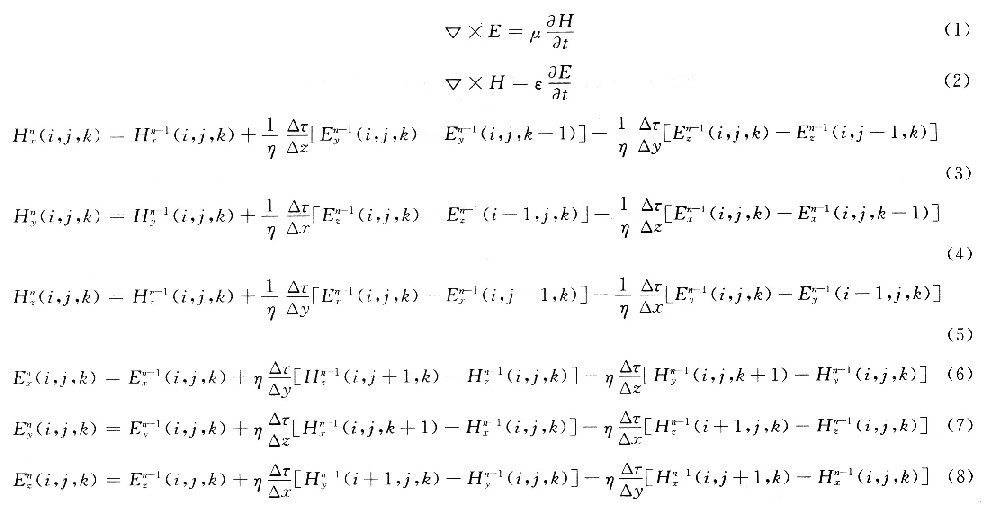
In the formula:

Is the wave impedance in the medium; Δτ=vΔt is the distance that a time step wave travels in space;

It is the phase velocity of the wave in the medium, where ε is the dielectric constant of the medium and μ is the permeability of the medium.
The use of numerical calculation space is always limited. In order to calculate the amount of electromagnetic field in a finite space, special treatment of the surrounding boundary of the finite space is required. In the FDTD, the PML (Perfect Match Layer) technology can be used to set the calculation area to vacuum, and there are scatterers and outward waves in the calculation area. The calculation area is surrounded by the PML absorption medium, and the PML medium is an ideal conductor.
The basic multi-band monopole antenna structure is shown in Figure 1. The PCB board is made of general-purpose FR4 material with a thickness of 1 mm and a size of 40 mm × 105 mm. The main radiating element of the antenna forms two radiating branches by slotting. The lengths of the two radiating branches are different. By adjusting the length of the radiating branch, the antenna can obtain two resonant frequencies, corresponding to 900 MHz and 1800 MHz, respectively. The grounded radiation piece close to the feeder is used to adjust the high-end resonant frequency, so that the working range of the high frequency band can meet the TD-SCDMA requirements, and the final size of the antenna radiating element is determined by optimization of the simulation software.
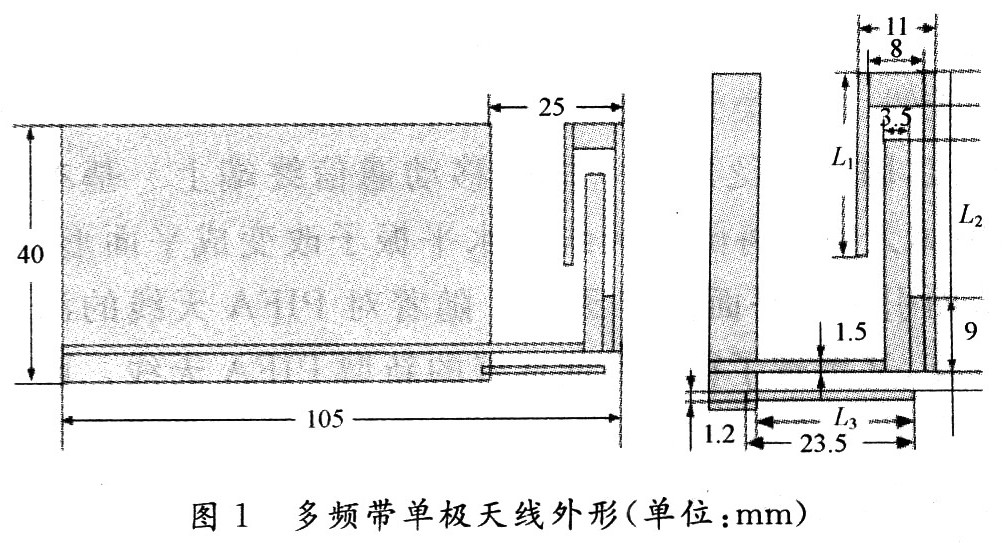
This article refers to the address: http://
Figure 2 shows the effect of grounded parasitic radiation branches on the operating band of the antenna. It can be seen from Fig. 2(a) that in the absence of grounded radiation branches, the antenna can only cover GSM900 and DCSl800, and the operating band of the antenna is effectively expanded by adding grounded radiation branches. Figure 2(b) shows the effect of the length L3 of the grounded radiation branch on the high frequency band of the antenna. The maximum operating band can be obtained by adjusting its length so as to partially overlap the resonant frequency of the short radiating branch of the main radiating piece.

The effect of the structural size of the main radiating element in the antenna on the return loss of the antenna is shown in Figure 3. Figure 3(a) shows that the longer the length L2 of the long-radiation branch, the lower the center frequency of the 900 MHz operating band, the narrower the operating bandwidth, and the lower the operating frequency of 1 800 MHz, resulting in wider bandwidth; (b) shows that adjusting the length L1 of the short-radiation branch has little effect on the 900 MHz operating band, while the lower limit of the operating band of 1 800 MHz becomes lower, widening the operating bandwidth. Through software optimization, the optimal structural size is obtained to meet the antenna design requirements.
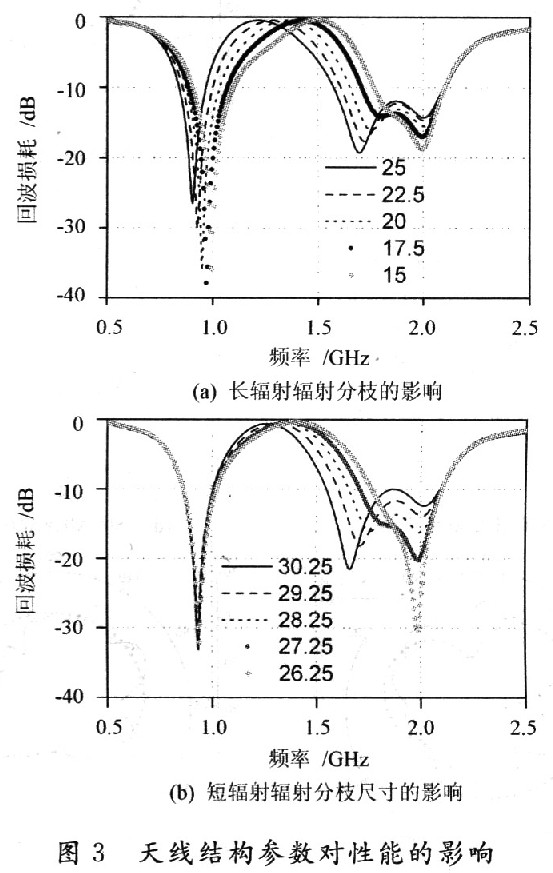
2 Data simulation and test results Through the above simulation analysis, the S11 parameter of the antenna input is guaranteed to be less than -10 dB, and the structural size of the antenna is finally determined, where L1=21.3 mm, L2=18.75 mm, L3=22 mm . According to the optimized antenna structure, a test antenna was fabricated, as shown in Fig. 4. The antenna characteristics were measured using an Agilent Vector Network Analyzer E5701B (frequency range 300 kHz to 6 GHz), and the actual measurement frequency range of the antenna S11 was 0.5 to 2.5 GHz. Figure 5 shows the measurement results and simulation results of the antenna S11. It can be obtained from the simulation data that the antenna operates at 863 to 973 MHz in the low frequency band and the operating frequency in the high frequency band is 1 690 to 2 100 MHz. The actual experimental antenna is operated at 888 to 990 MHz in the low frequency band. It is slightly wider than the GSM900 (890 ~ 960 MHz) operating band, and the high frequency band operates at 167 to 2 200 MHz, covering all operating bands of DCS/PCS/TD-SCDMA (1 710 to 2 025 MHz). At the same time, it can be seen from the figure that the actual test results are in good agreement with the simulated data in the GSM900. In the DCS/PCS/TD-SCDMA high frequency band, the measured data and the simulation data are slightly deviated. The test antenna has a resonance point at 1 860 MHz, and the resonant frequency of the parasitic radiation branch is relatively high.
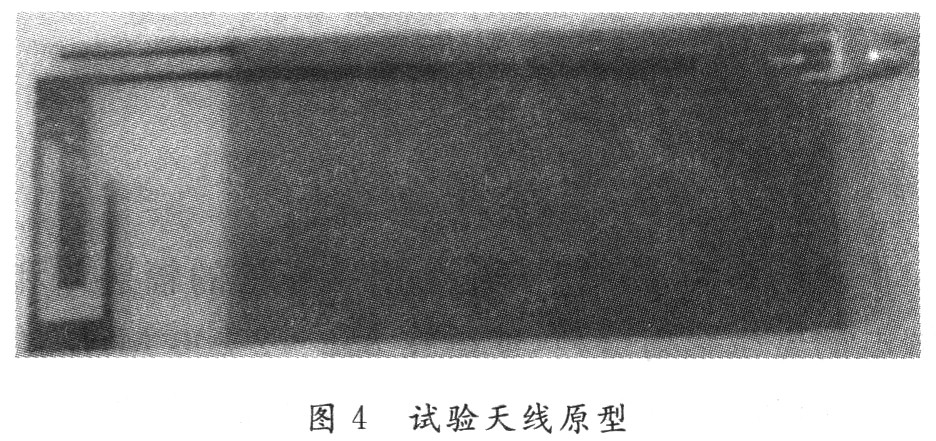
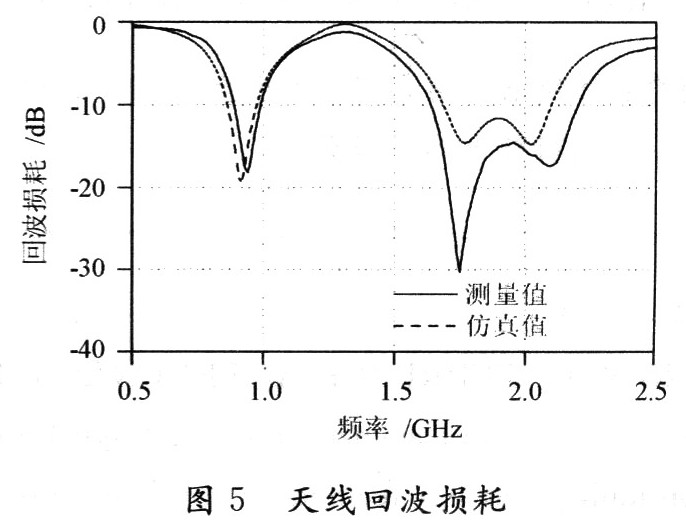
Figure 6 compares the antenna simulation pattern with the test pattern of the test antenna. It can be seen from the simulated antenna pattern that the antenna pattern is very close to the typical monopole antenna pattern, and the radiation pattern in the vertical plane has better omnidirectional performance, and the operating frequency is increased to increase the lobe in the horizontal pattern. However, the omnidirectional characteristics are still maintained in the vertical plane. Comparing the simulated direction diagram with the actual test direction diagram, the shape of the two is very different due to the fluctuation of the test data, but the measured direction diagram is basically the same in amplitude compared with the simulation data.

3 Conclusion The proposed multi-band monopole antenna uses a slotted radiating plate and a parasitic radiating branch of the coupled feed, so that multiple resonant frequencies can be obtained in the frequency range of 888 to 2 200 MHz, so the antenna can be designed to meet GSM900. /DCSl800/PCSl900 and TD-SCDMA dual-mode mobile communication terminals for antenna requirements. The test antenna fabricated by the simulated antenna structure has a return loss that meets the design requirements and is consistent with the software simulation results.
The multi-band monopole antenna proposed in this paper has a very low altitude, but the distance from the ground plane is still reduced. Further, the improvement measures of the bandwidth shortening caused by the shortening of the distance can be further studied. At the same time, it is considered that the future communication may use 2.3~2. In the .4 GHz band, it is possible to continue to study monopole antennas with wider bandwidths.









